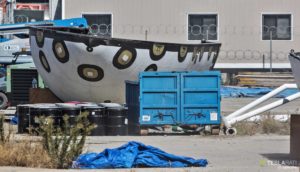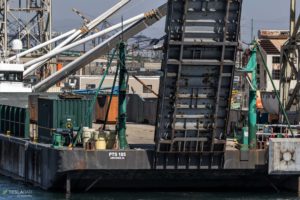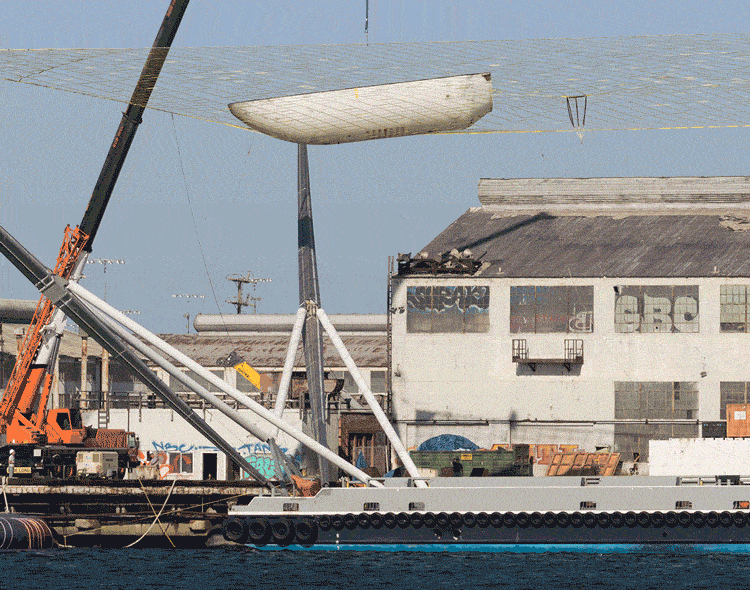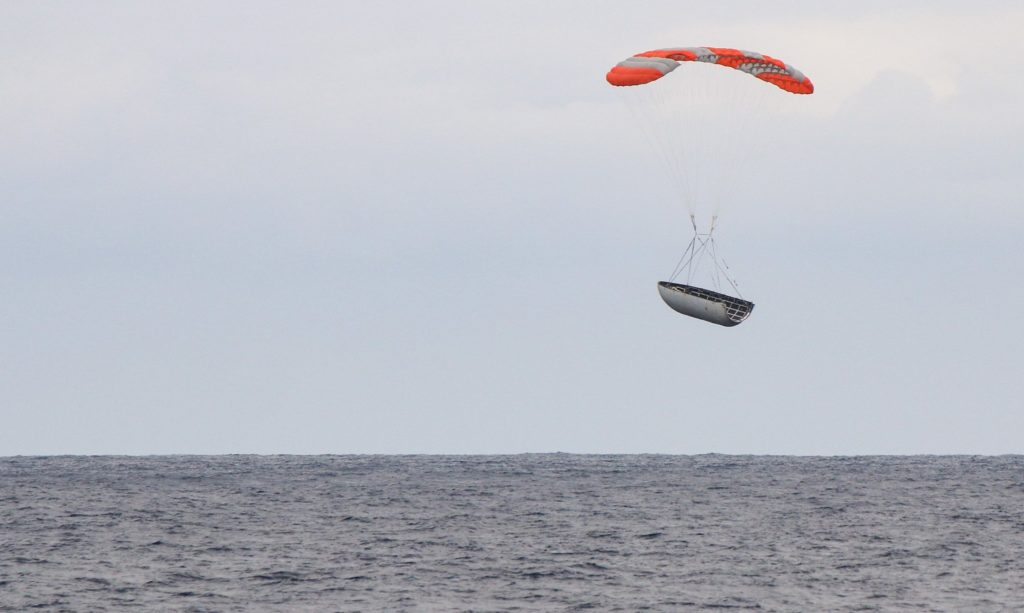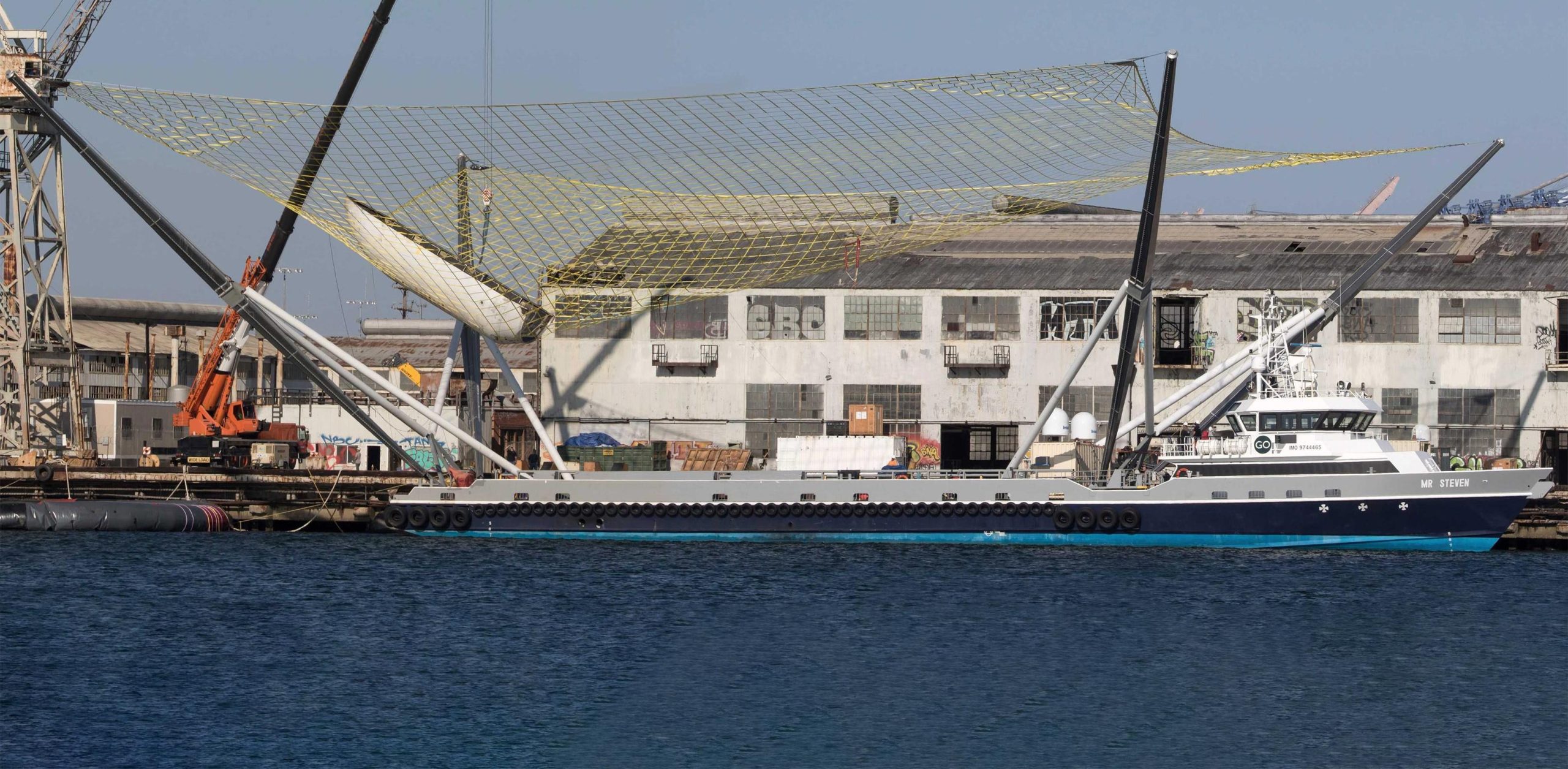
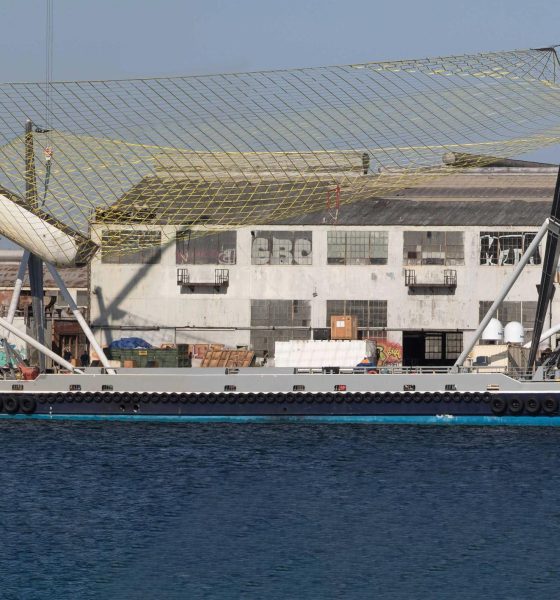
News
SpaceX attempts second Falcon fairing drop test with a helicopter and Mr. Steven
Following a few days of rest in port, SpaceX fairing recovery vessel Mr. Steven has continued a likely campaign of controlled drop tests with a second fairing recovery attempt, using a helicopter, spotter plane, and support vessel to pick up a Falcon fairing and drop it, theoretically allowing it to paraglide into Mr. Steven’s net.
While it’s nearly impossible to determine what happened without line-of-sight visual confirmation or an official announcement from SpaceX, it appears that Mr. Steven kicked off real catch attempts on October 11th, evidenced by his close interaction with a Blackhawk helicopter over the course of an hour or so. Another similar attempt occurred today, October 17th, and culminated with Mr. Steven returning once more to Port of San Pedro with the same test-focused fairing half on board, albeit not resting in his retracted net.
- SpaceX’s dedicated test fairing seen at Berth 240 on Oct. 15, a few days after its first apparent drop test. (Pauline Acalin)
- Mr. Steven and a recent arrival, barge PTS 185. The fairing cradle on deck suggests that this is probably the platform helicopters grab the fairing half off of. (Pauline Acalin)
After October 11th’s testing was completed, Mr. Steven returned to Port of San Pedro. On October 13th, he was docked at SpaceX’s Berth 240 facilities with net lowered and the test fairing half wrapped up on the docks, preventing confirmation of whether he carried the fairing half back from the testing region. A mid-sized barge also recently appeared at Berth 240 with a distinct Falcon fairing cradle onboard, perhaps explaining the presence of a tugboat (named Sir Richard) a few miles away from where this test campaign has been stationed – a barge would offer a flat, safe surface for a helicopter to hover over and pick up an unwieldy object such as a payload fairing.
Nearly identical to the October 11th test, Mr. Steven, tug Sir Richard, a Cessna chase plane, and a Blackhawk helicopter all converged around 100 miles southwest of Port of Los Angeles around 2pm PDT on October 17th prior to beginning recovery test operations. Mr. Steven and the tug Sir Richard – likely towing a barge being temporarily used to move a fairing half – arrived several hours beforehand at the test’s planned location.
- As of late, SpaceX technicians and engineers have going through quite a range of activities related to fairing recovery. (Pauline Acalin)
- A gif demonstrates just how taut Mr Steven’s net can be, thanks to mechanized rigging. 08/13/18 (Pauline Acalin)
- Mr. Steven returned to Port of San Pedro around 7pm on October 8th after a day spent at sea, apparently with a Falcon fairing half in tow. This is the second known time that a fairing has been in Mr. Steven’s net. (Pauline Acalin)
- One half of SpaceX’s Iridium-6/GRACE-FO just moments before touchdown on the Pacific Ocean. (SpaceX)
Eventually, a UH-60A Blackhawk helicopter – the same helicopter used on October 11 – lifted off from Catalina Island’s Avalon airport, taking about half an hour to reach Mr. Steven and Sir Richard. Once there, the helicopter very distinctly slowed down, eventually hovering just ~20 feet off the surface of the ocean, if not outright landing or perching on the aforementioned barge under the tug’s control. After several minutes in that state, the Blackhawk lifted off and immediately began climbing, reaching a peak of ~11,000 ft before (presumably) dropping its fairing payload and immediately diving down to follow its descent.
It’s undoubtedly an imperfect fit, but the helicopter appeared to follow Mr. Steven very closely over the course of the recovery attempt, sticking just a ~1500 ft or less above and a few hundred feet beside him as he raced to catch the falling fairing half. In fact, at least as a very rough approximation, the helicopter’s descent may be useful to judge the fairing’s behavior while gliding: taking ~14 minutes to travel descend 11,000ft and travel perhaps 2 miles (~10,500ft) horizontally, the fairing would dropped at a reasonable 13.1 feet per second (~4 m/s) once its parafoil opened and seemed to travel approximately one foot forward for every one foot down, also known as a 1:1 glide slope ratio.
And here's a little overview of the helicopter's path, mixed with a speed/altitude graph! Added some rough annotations to give an idea of what happened and in what time frame 😀 pic.twitter.com/e1rwZtkNHA
— Eric Ralph (@13ericralph31) October 18, 2018
Depending on wind conditions, parafoils can nominally be expected to achieve average glide slope ratios between 0 (high winds; falling like a literal rock) and 4 (no winds; almost as good as a bad airplane), meaning that Falcon fairings – judging from tangential data gathered from the helicopter following its descent – fly much like a parafoil, which is to say not great but better than a brick. The trick with parafoil control – which includes tweaking angles of attack and glide slope – lies more in the art of trading forward velocity for vertical velocity (or vice versa) at key moments. Assuming their control mechanisms have enough authority, paragliding fairings could ‘flare’ as they near Mr. Steven’s net, essentially angling upwards to briefly hover before dropping quickly, maybe giving the boat enough time to swoop in and place its net just beneath it.
In this way, a parafoil’s flexible, inflated wing (airfoil, to be precise) can allow it to maneuver quite a lot like a bird, at least more so than most other methods of flying humans have access to. Time will tell if SpaceX is having any luck perfecting the guidance and recovery of Falcon fairings, particularly with this campaign of under-the-radar drop tests. Even if Mr. Steven returns with a fairing half resting in his net, it will be more than a little ambiguous if it was placed there or he caught it, and any certainty will rely on official confirmation from SpaceX itself.
For prompt updates, on-the-ground perspectives, and unique glimpses of SpaceX’s rocket recovery fleet check out our brand new LaunchPad and LandingZone newsletters!

Elon Musk
Elon Musk’s Grok records lowest hallucination rate in AI reliability study
Grok achieved an 8% hallucination rate, 4.5 customer rating, 3.5 consistency, and 0.07% downtime, resulting in an overall risk score of just 6.

A December 2025 study by casino games aggregator Relum has identified Elon Musk’s Grok as one of the most reliable AI chatbots for workplace use, boasting the lowest hallucination rate at just 8% among the 10 major models tested.
In comparison, market leader ChatGPT registered one of the highest hallucination rates at 35%, just behind Google’s Gemini, which registered a high hallucination rate of 38%. The findings highlight Grok’s factual prowess despite the AI model’s lower market visibility.
Grok tops hallucination metric
The research evaluated chatbots on hallucination rate, customer ratings, response consistency, and downtime rate. The chatbots were then assigned a reliability risk score from 0 to 99, with higher scores indicating bigger problems.
Grok achieved an 8% hallucination rate, 4.5 customer rating, 3.5 consistency, and 0.07% downtime, resulting in an overall risk score of just 6. DeepSeek followed closely with 14% hallucinations and zero downtime for a stellar risk score of 4. ChatGPT’s high hallucination and downtime rates gave it the top risk score of 99, followed by Claude and Meta AI, which earned reliability risk scores of 75 and 70, respectively.

Why low hallucinations matter
Relum Chief Product Officer Razvan-Lucian Haiduc shared his thoughts about the study’s findings. “About 65% of US companies now use AI chatbots in their daily work, and nearly 45% of employees admit they’ve shared sensitive company information with these tools. These numbers show well how important chatbots have become in everyday work.
“Dependence on AI tools will likely increase even more, so companies should choose their chatbots based on how reliable and fit they are for their specific business needs. A chatbot that everyone uses isn’t necessarily the one that works best for your industry or gives accurate answers for your tasks.”
In a way, the study reveals a notable gap between AI chatbots’ popularity and performance, with Grok’s low hallucination rate positioning it as a strong choice for accuracy-critical applications. This was despite the fact that Grok is not used as much by users, at least compared to more mainstream AI applications such as ChatGPT.
News
Tesla (TSLA) receives “Buy” rating and $551 PT from Canaccord Genuity
He also maintained a “Buy” rating for TSLA stock over the company’s improving long-term outlook, which is driven by autonomy and robotics.

Canaccord Genuity analyst George Gianarikas raised his Tesla (NASDAQ:TSLA) price target from $482 to $551. He also maintained a “Buy” rating for TSLA stock over the company’s improving long-term outlook, which is driven by autonomy and robotics.
The analyst’s updated note
Gianarikas lowered his 4Q25 delivery estimates but pointed to several positive factors in the Tesla story. He noted that EV adoption in emerging markets is gaining pace, and progress in FSD and the Robotaxi rollout in 2026 represent major upside drivers. Further progress in the Optimus program next year could also add more momentum for the electric vehicle maker.
“Overall, yes, 4Q25 delivery expectations are being revised lower. However, the reset in the US EV market is laying the groundwork for a more durable and attractive long-term demand environment.
“At the same time, EV penetration in emerging markets is accelerating, reinforcing Tesla’s potential multi‑year growth runway beyond the US. Global progress in FSD and the anticipated rollout of a larger robotaxi fleet in 2026 are increasingly important components of the Tesla equity story and could provide sentiment tailwinds,” the analyst wrote.
Tesla’s busy 2026
The upcoming year would be a busy one for Tesla, considering the company’s plans and targets. The autonomous two-seat Cybercab has been confirmed to start production sometime in Q2 2026, as per Elon Musk during the 2025 Annual Shareholder Meeting.
Apart from this, Tesla is also expected to unveil the next-generation Roadster on April 1, 2026. Tesla is also expected to start high-volume production of the Tesla Semi in Nevada next year.
Apart from vehicle launches, Tesla has expressed its intentions to significantly ramp the rollout of FSD to several regions worldwide, such as Europe. Plans are also underway to launch more Robotaxi networks in several more key areas across the United States.
News
Waymo sues Santa Monica over order to halt overnight charging sessions
In its complaint, Waymo argued that its self-driving cars’ operations do not constitute a public nuisance, and compliance with the city’s order would cause the company irreparable harm.

Waymo has filed a lawsuit against the City of Santa Monica in Los Angeles County Superior Court, seeking to block an order that requires the company to cease overnight charging at two facilities.
In its complaint, Waymo argued that its self-driving cars’ operations do not constitute a public nuisance, and compliance with the city’s order would cause the company irreparable harm.
Nuisance claims
As noted in a report from the Los Angeles Times, Waymo’s two charging sites at Euclid Street and Broadway have operated for about a year, supporting the company’s growing fleet with round-the-clock activity. Unfortunately, this has also resulted in residents in the area reportedly being unable to sleep due to incessant beeping from self-driving taxis that are moving in and out of the charging stations around the clock.
Frustrated residents have protested against the Waymos by blocking the vehicles’ paths, placing cones, and “stacking” cars to create backups. This has also resulted in multiple calls to the police.
Last month, the city issued an order to Waymo and its charging partner, Voltera, to cease overnight operations at the charging locations, stating that the self-driving vehicles’ activities at night were a public nuisance. A December 15 meeting yielded no agreement on mitigations like software rerouting. Waymo proposed changes, but the city reportedly insisted that nothing would satisfy the irate residents.
“We are disappointed that the City has chosen an adversarial path over a collaborative one. The City’s position has been to insist that no actions taken or proposed by Waymo would satisfy the complaining neighbors and therefore must be deemed insufficient,” a Waymo spokesperson stated.
Waymo pushes back
In its legal complaint, Waymo stated that its “activities at the Broadway Facilities do not constitute a public nuisance.” The company also noted that it “faces imminent and irreparable harm to its operations, employees, and customers” from the city’s order. The suit also stated that the city was fully aware that the Voltera charging sites would be operating around the clock to support Waymo’s self-driving taxis.
The company highlighted over one million trips in Santa Monica since launch, with more than 50,000 rides starting or ending there in November alone. Waymo also criticized the city for adopting a contentious strategy against businesses.
“The City of Santa Monica’s recent actions are inconsistent with its stated goal of attracting investment. At a time when the City faces a serious fiscal crisis, officials are choosing to obstruct properly permitted investment rather than fostering a ‘ready for business’ environment,” Waymo stated.
